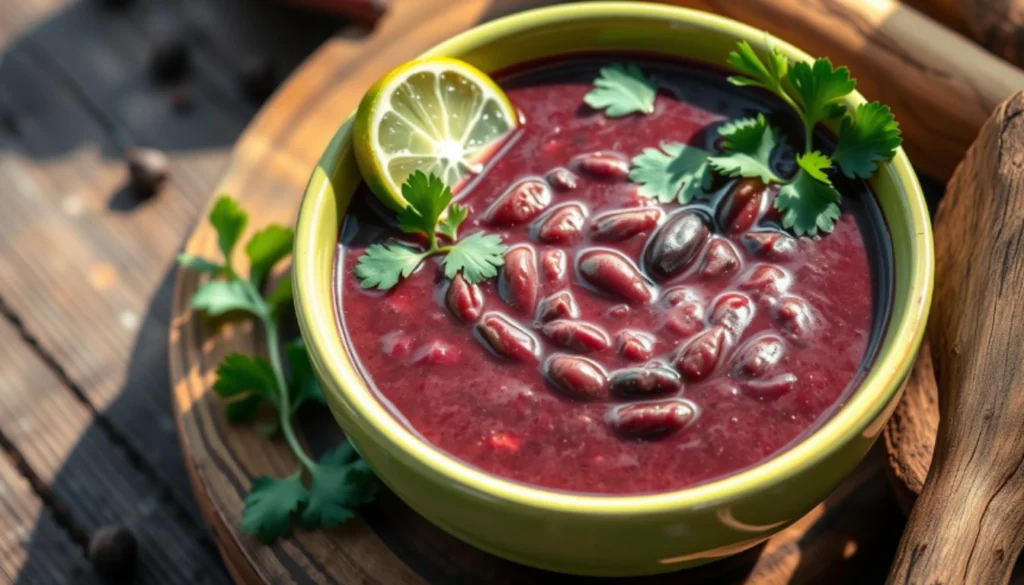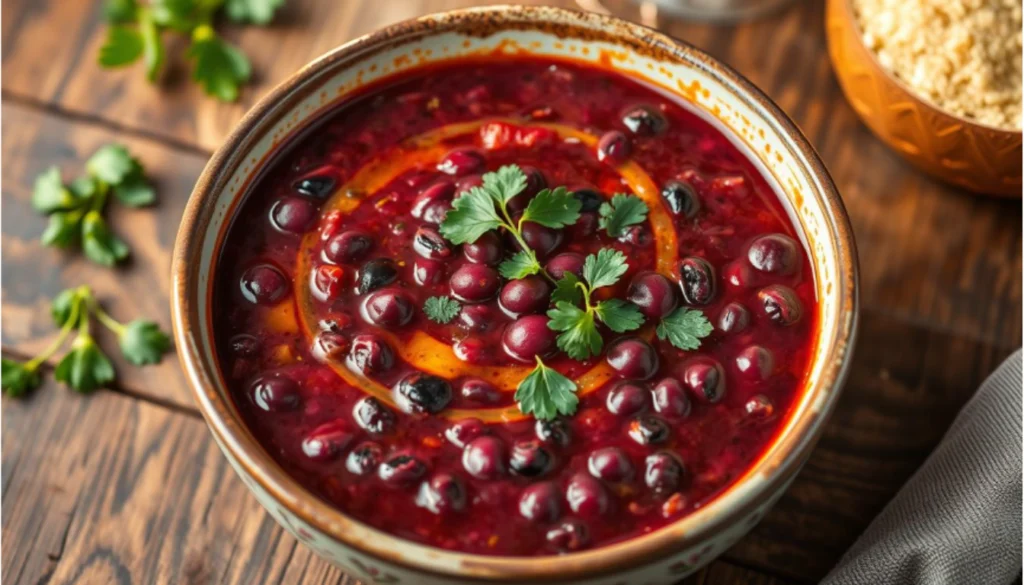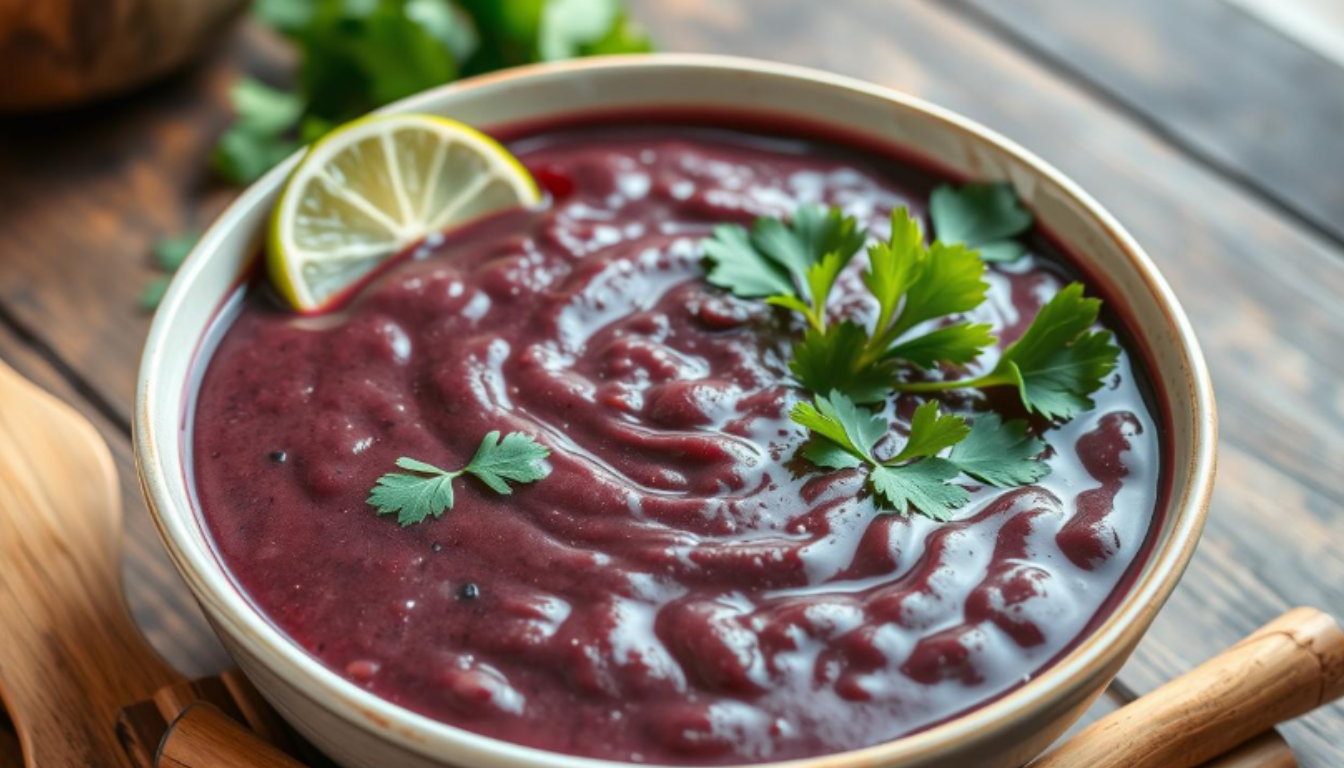Why do black beans turn purple?
Ever noticed how black beans sometimes turn a deep purple when you cook them? It’s like magic in your kitchen! Whether you’re whipping up a hearty soup or a fresh salad, the color change is hard to miss. But here’s the thing—it’s not just for show. There’s a fascinating bit of science behind why black beans undergo this transformation. Spoiler alert: it has a lot to do with natural pigments and how they react to heat and water.
In this article, we’ll break it all down—from the chemistry of those vibrant hues to the cultural significance of black beans. Plus, we’ll throw in some handy cooking tips to help you keep those gorgeous colors popping on your plate. Let’s get started!
Table of contents
Introduction to Black Beans and Their Color Change
What Makes Black Beans Unique?
Black beans aren’t just your average legume. Known as frijoles negros in Latin America or turtle beans in some parts of the U.S., they’ve been a staple ingredient in kitchens for centuries. Their shiny black shells and earthy flavor make them a go-to for soups, stews, salads, and more.
But what really sets black beans apart is their anthocyanin-rich outer skin. This natural pigment gives the beans their signature dark color—and yes, it’s also the star behind the dramatic purple hue you see when they cook.
Why Do They Change Color?
The purple magic happens when those anthocyanins meet water and heat. Think of it like this: as the beans cook, their tough outer skin softens, releasing the pigments into the water. Depending on the cooking conditions, you might get anything from a deep purple to a bluish tint. And guess what? That colorful water is totally safe to eat—it’s packed with antioxidants!
Pretty cool, huh? In the next section, we’ll dive into the science behind these pigments and what makes them so special.
The Science Behind Black Bean Pigmentation
Anthocyanins: The Pigment Powerhouse
When asking, “Why do black beans turn purple?”, the answer lies in anthocyanins. These are natural pigments found in the outer skin of black beans, responsible for their dark, glossy appearance. Anthocyanins don’t just stop at black beans—you’ll find them in foods like blueberries, red cabbage, and even purple sweet potatoes.
Here’s the kicker: anthocyanins are water-soluble, meaning they dissolve when beans are soaked or cooked. The result? That eye-catching purple tint in your pot. Not only do they add color, but they’re also full of antioxidants, which help fight off harmful free radicals in your body. So, while it might seem like a simple color change, it’s actually a little health boost too!
How Cooking Triggers Color Changes
Heat is the secret sauce behind the transformation. When you cook black beans, the heat breaks down the outer layer, allowing the pigments to escape. This is why you’ll often see the cooking water turn purple before the beans do.
But there’s more: the final color depends on factors like cooking time, temperature, and even the type of water you use. It’s chemistry in action! Keep reading, because Part 3 explains how these factors influence the vivid purple hue.

Factors Influencing the Purple Hue
The Role of pH Levels in Color Change
If you’re still wondering, “Why do black beans turn purple?”, here’s another layer to the story—pH levels. Anthocyanins are super sensitive to their environment, especially the acidity or alkalinity of the cooking water.
- Acidic Water: If you add vinegar or lime juice to your pot, the anthocyanins lean more reddish-purple. This happens because acids stabilize the pigments, intensifying their color.
- Neutral Water: Cooking in plain water typically results in that classic deep purple we all recognize.
- Alkaline Water: Adding something like baking soda shifts the color to blue or even green. (Honestly, it’s fun to experiment, but green beans might not look as appetizing!)
How Cooking Methods Impact Pigmentation
The way you cook black beans also affects their color. Boiling, steaming, and pressure cooking all play a role:
- Boiling: The most common method, it allows anthocyanins to escape into the water, creating that rich purple liquid.
- Steaming: Retains more of the pigment in the beans since they’re not submerged in water.
- Pressure Cooking: Speeds up the process but can break down pigments faster due to higher heat.
So, the next time you see those purple hues, you’ll know they’re a combination of science, art, and a little bit of culinary flair! Up next, we’ll explore how different black bean varieties and storage conditions influence their color.
Variations in Black Beans
Differences Among Black Bean Varieties
Not all black beans are created equal, and this might help answer “Why do black beans turn purple?” Different varieties of black beans have varying levels of anthocyanins, which affect how much color they release during cooking. Some beans have a higher concentration of these pigments, creating a more vivid purple hue. Others, like older or less vibrant varieties, might not release as much color.
Regional differences also play a role. Beans grown in certain areas may have unique properties based on the soil and climate. For example, beans cultivated in warmer climates might have tougher skins, which can impact how the pigments are released.
How Age and Storage Affect Color
Did you know that the age of your black beans affects their ability to turn purple? Fresher beans tend to retain their natural pigments better, resulting in that signature purple tint when cooked. Older beans, especially those stored for long periods in less-than-ideal conditions, may lose their anthocyanin content over time.
Keep your beans in a dark, cool spot for optimal results. Avoid exposing them to light or humidity, which can degrade their quality. If you’re using older beans, don’t worry—they’ll still taste great, even if they don’t produce that dramatic color change.
Looking for more ways to work with legumes? Check out Purple Black Bean Soup Recipe for another hearty and comforting dish.
Part 5: Cultural and Culinary Significance
Black Beans in Traditional Dishes
Across cultures, black beans hold a special place in the culinary world. Whether you’re enjoying a Cuban Moros y Cristianos (black beans and rice) or Brazil’s beloved Feijoada (a rich bean and meat stew), these legumes bring a deep, earthy flavor that’s hard to beat. In many traditional dishes, the color transformation of black beans into purple adds visual appeal, making the dish even more inviting.
In Mexican cuisine, black beans are a staple in burritos, tacos, and enchiladas. Their ability to adapt to various spices and seasonings makes them a favorite ingredient for home cooks and chefs alike.
The Visual Appeal of Purple-Tinted Black Beans
Let’s be real—food is as much about presentation as it is about taste. The purple hue of black beans doesn’t just showcase their unique chemistry; it also elevates the look of a dish. Imagine a fresh salad sprinkled with vibrant, purple-tinted beans—it’s the kind of pop that makes you want to dig in immediately.
Purple is often associated with health and vitality, so adding these beans to your meal can give it an instant nutritious vibe. For a colorful addition to your plate, consider pairing them with this Easy Spanish Cebolla Ensalada, which complements black beans beautifully.

Nutritional Benefits of Anthocyanins
Antioxidant Properties of Purple Pigments
Anthocyanins—the compounds responsible for the purple color in black beans—aren’t just pretty to look at; they’re nutritional powerhouses. These antioxidants help fight free radicals, reducing oxidative stress in the body. Translation? They protect your cells from damage and help lower the risk of chronic diseases like heart disease and cancer.
But wait, there’s more! Anthocyanins also support brain health by improving blood flow to the brain. Some studies suggest they can even slow age-related cognitive decline. So, when you see that vibrant purple hue in your beans, you’re not just cooking dinner—you’re adding a boost of brainpower to your meal.
Anthocyanins and Their Health Benefits
Eating anthocyanin-rich foods, like black beans, can also improve your metabolic health. These pigments may help regulate blood sugar levels and enhance insulin sensitivity, which is great news for those managing diabetes or pre-diabetes.
Plus, anthocyanins have anti-inflammatory properties. They can reduce inflammation in the body, easing conditions like arthritis and promoting overall wellness.
If you’re a fan of colorful, nutritious meals, black beans deserve a regular spot on your menu. They’re proof that food can be as visually stunning as it is healthy!
How to Preserve Black Bean Color When Cooking
Best Cooking Practices for Retaining Color
Let’s be honest—nobody likes dull-looking beans. If you’re aiming for that beautiful purple tint, the way you cook matters. To retain the vibrant color, avoid overcooking your black beans. Prolonged heat can degrade anthocyanins, causing the color to fade. Instead, simmer them on low to medium heat and check for doneness frequently.
Another trick? Use acidic ingredients sparingly during cooking. While adding lime juice or vinegar can enhance the purple hue, doing it too early can toughen the beans and extend cooking time. Save those acids for the end, right before serving.
Managing Water Quality and Ingredients
Believe it or not, the type of water you use makes a difference. Hard water, which contains minerals like calcium and magnesium, can dull the pigments, turning your beans gray or green. Soft water or filtered water works best for retaining that signature purple tint.
For extra color preservation, consider steaming your beans instead of boiling them. This method keeps more of the anthocyanins intact since they don’t leach into the water.
Ready to experiment? These tips will help you serve up a pot of black beans that’s as vibrant as it is tasty. And for another visually stunning recipe, check out Easy Spanish Cebolla Ensalada, which pairs beautifully with black beans.
Frequently Asked Questions About Black Bean Color
Do All Black Beans Turn Purple?
Not every batch of black beans will turn purple, and that’s perfectly normal! The color transformation depends on factors like the variety of the beans, their freshness, and how they’re cooked. For instance, beans with a higher concentration of anthocyanins are more likely to show off that vibrant hue.
Older beans, or those stored improperly, may lose some of their pigments over time, resulting in a less noticeable color change. Additionally, cooking conditions like pH levels and water quality can also impact the final appearance.
So, if you’re asking, “Why do black beans turn purple?” and yours don’t, rest assured—they’re still delicious and nutritious!
Does Color Change Affect Flavor or Nutrition?
Nope, the color change doesn’t affect the flavor. Whether your beans turn purple or not, they’ll still have that earthy, slightly sweet taste we all love. And the nutritional benefits? Still there.
The purple tint comes from anthocyanins, which are loaded with antioxidants. Even if your beans don’t visibly change color, they’re still packed with these compounds, promoting good health with every bite.
Curious about more cooking tips and tricks? Check out Benigni’s Potato Soup Recipe for another comforting and wholesome dish to try!
Conclusion: Celebrating the Beauty of Black Beans
A Blend of Science and Cuisine
Black beans are more than just a pantry staple—they’re a testament to the fascinating intersection of science and food. The answer to “What causes black beans to turn purple??” lies in their natural anthocyanins, which not only create a visual feast but also offer incredible health benefits.
The Marvel of Everyday Ingredients
From their ability to transform into vibrant hues to their versatility in countless dishes, black beans are a true culinary marvel. Whether you’re simmering a pot of beans for a hearty stew or adding them to a fresh salad, their color change adds a touch of magic to any meal.
So next time you cook black beans, take a moment to appreciate the science behind the purple and the nutritional powerhouse they bring to the table. For more colorful cooking inspiration, don’t miss this Easy Spanish Cebolla Ensalada Recipe, a perfect pairing for black beans.

